Unsure about your French table manners? Click Here to download > > How to avoid these 10 food etiquette mistakes !
- Home ›
- Destinations ›
- Normandy ›
- Cathédrale de Rouen
7 Thematic Ways to Explore Rouen Cathedral, A Gothic Masterpiece
Published 31 March 2024 by Leyla Alyanak — Parisian by birth, Lyonnaise by adoption, historian by passion
Rouen is the capital of Normandy, but its cathedral is, in a way, the “capital” of Rouen. It is Rouen's most prestigious monument and deserves to be explored in detail. You can do it any way you like but I've divided the visit into seven topics, or themes, through which to discover this amazing building.
Even if you don’t care about architectural style, if the Middle Ages make you yawn, or if you think Gothic means wearing black eye makeup, Rouen Cathedral will make you sit up and take notice. This may be the beginning of your love affair with these buildings.
I only say this because it’s what happened to me.
I’ve never been a huge fan of religious architecture but when I first set eyes on the façade of Notre-Dame de Rouen, I almost lost the ability to breathe for a second. Exploring this magnificent building is one of the unmissable and most rewarding things to do in Rouen.
NOTE: Pages on this site may contain affiliate links, which support this site. See full Privacy Policy here.
Taking in the filigree that decorates this cathedral's exterior is like trying to deconstruct a piece of lace: intricate, delicate, overwhelming, and ultimately impossible.
The design, the balance, the exquisite carving – it’s as though someone designed the most complicated building possible, and then doubled the work.
To build this from scratch might have been impossible, but by adding layer upon layer, this beautiful gem finally emerged.
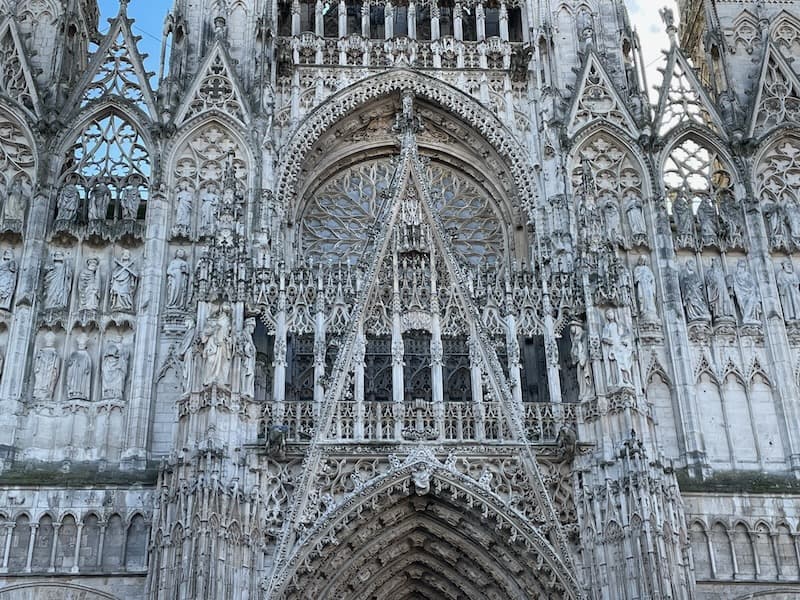
How to explore the Cathedral of Rouen
The cathedral is Rouen’s most prestigious building, reflecting more than 1000 years of tumultuous history, a muse for artists and a magnet for visitors.
You can approach in a variety of ways, depending on your interests, and I’ve applied seven different themes, or prisms, through which you can explore this spectacular structure. Whichever you choose, you will probably not walk away untouched.
1. Through history and resilience
If a building were to receive a prize for survival, this cathedral just might land in first place. Like the proverbial phoenix, it has been destroyed and reborn countless times.
- 9th century: this was the first destruction, courtesy of Viking raids, which left the original church damaged and in need of rebuilding.
- Reconstruction in the Romanesque style would begin in the 11th century, just a few years before the Norman invasion of England (so well depicted in the extraordinary Bayeux tapestry a two-hour train ride away). But in 1200, a major fire would devastate the cathedral and repairs would take nearly half a century.
- In 1562, as the Wars of Religion swept Europe, the Rouen Cathedral was ransacked by Huguenots. They damaged its façade, destroyed its statues, and generally vented their anti-Catholic sentiments.
- Then the hugely anti-clerical French Revolution came, and the cathedral, its religious function removed, turned into a “temple of reason”, as many churches were.
- 1822: Its original spire was made of wood and was destroyed by lightning, so a new one was built, with the more resilient and modern cast iron replacing the fire-prone wood.
- 1944: The Allies, fighting to displace German occupying forces during World War II, bombed Rouen, inflicting significant damages and destroying a large part of the cathedral, which would take a dozen years to repair. In fact, after the bombs fell it was nicknamed “Our Lady of the 7 Shells”.
- 1999: A violent storm damaged the cathedral yet again, kickstarting another round of repairs.
It never ends! But if nothing else, all these challenges underscore the cathedral’s immense resilience and the ongoing commitment of the Rouennais to rebuild and preserve their most beloved monument.
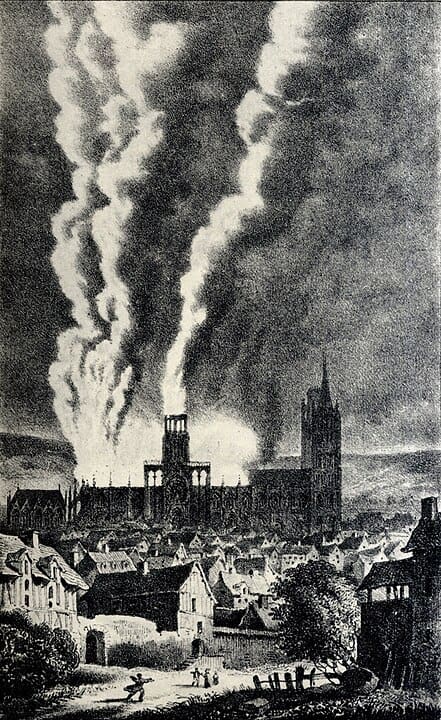 1822 fire. Giogo, public domain, via Wikimedia Commons 1822 fire. Giogo, public domain, via Wikimedia Commons |
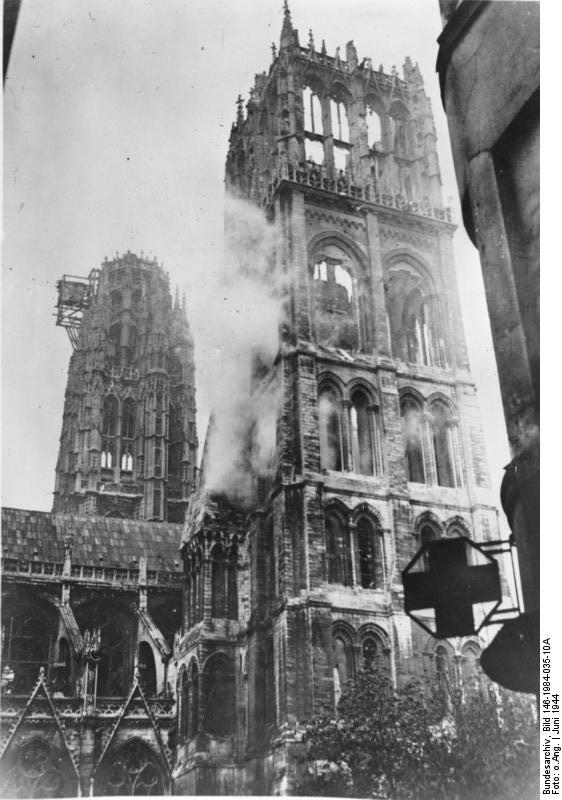 By Bundesarchiv, Bild 146-1984-035-10A CC BY-SA 3.0 de, via Wikimedia Commons By Bundesarchiv, Bild 146-1984-035-10A CC BY-SA 3.0 de, via Wikimedia Commons |
2. Through artistic inspiration
The cathedral has inspired one of the most cherished artists of recent times, Impressionist Claude Monet, who painted its western façade no fewer than 30 times, cementing the reputation of the city of Rouen as “capital of Impressionism”.
Because of its intricacy, each tiny patch of the cathedral's face absorbed light differently, depending on the time of day, almost driving Monet mad with the impossibility of capturing it fully. And so he kept trying. Below are three of his works.
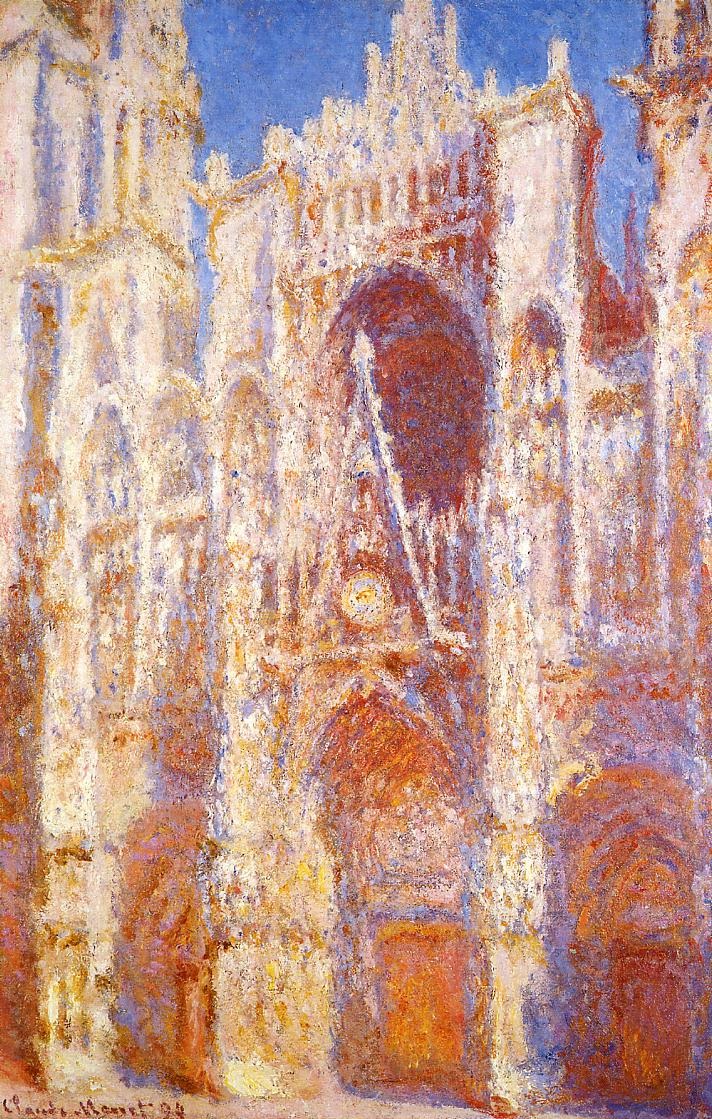
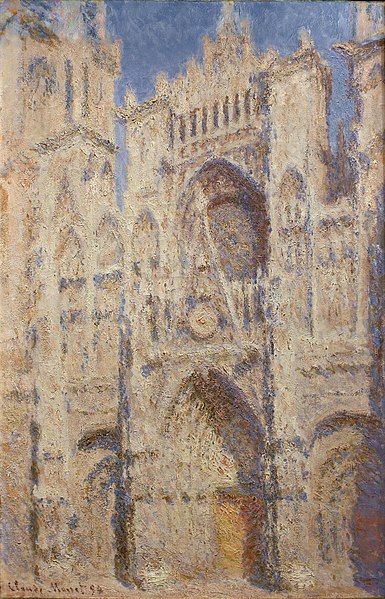
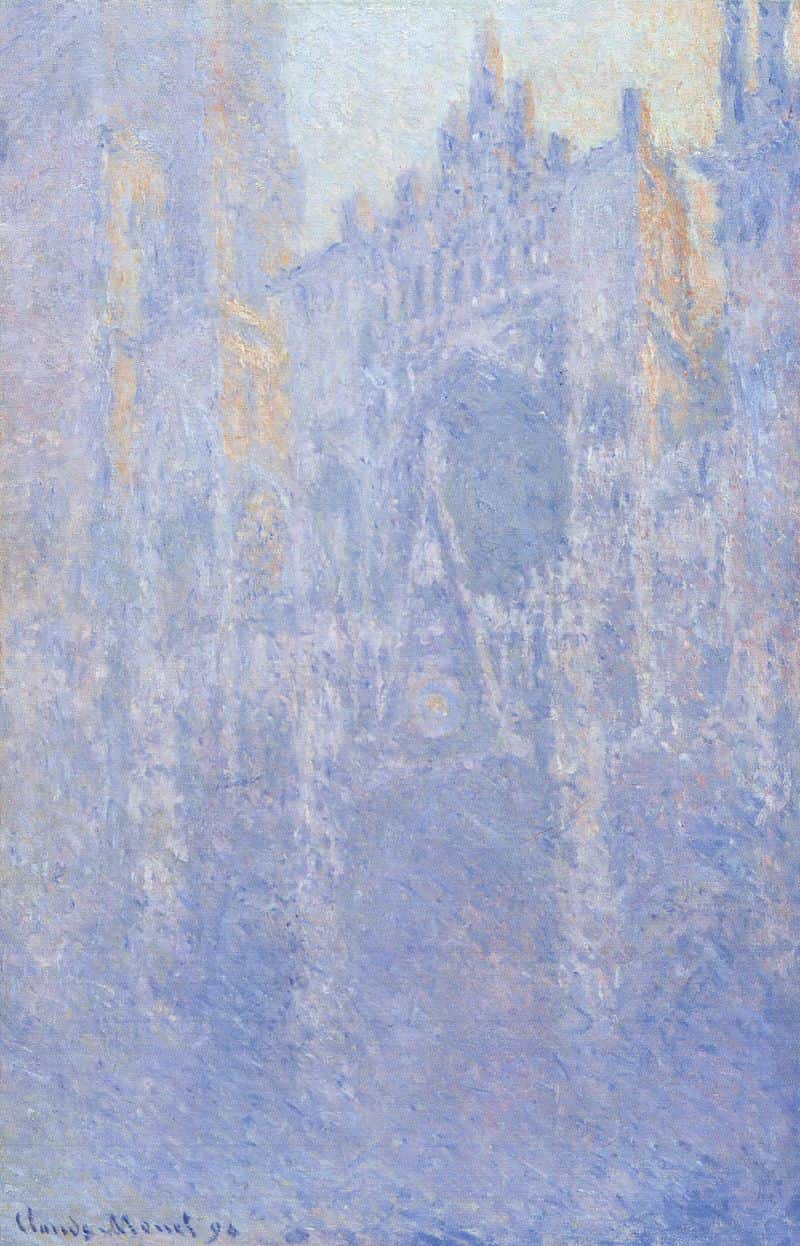
Camille Pissarro would also find inspiration here, as would Roy Lichtenstein and plenty of others.
The cathedral would also inspire writers, like Gustave Flaubert, a native of the city, and Victor Hugo, both of whom would often use the cathedral as a backdrop for their scenes.
CURIOUS ABOUT NORMANDY?
Here are a few trustworthy guidebooks to take along on your trip:
- Rick Steves’s Snapshot Normandy
- Moon Normandy and Brittany (With Mont-Saint-Michel)
- Michelin Green Guide Normandy (2020)
3. Through architectural evolution
If there’s one thing the cathedral is famous for, it’s the different styles it has worn over the centuries.
While there are no visible vestiges of the Gallo-Roman church that once stood here, a piece of wall from the 12th century remains from the Romanesque cathedral, visible on the left if you’re facing the main western entrance.
The original Romanesque cathedral, commissioned by Archbishop Robert the Dane around 1030, featured most of the elements we have today and would set the stage for the cathedral's later developments.
The Gothic movement would begin with the rebuilding of the cathedral after the dreadful 1200 fire. We would see the arrival of those oh-so-Gothic features, the pointed arches and flying buttresses that let in more light and allowed for higher ceilings.
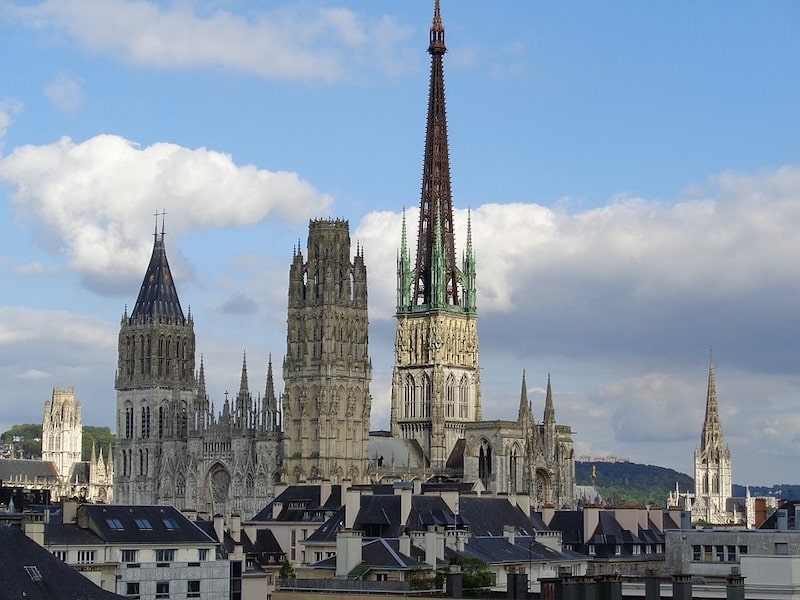 Rouen Cathedral, in all its Gothic glory. By Philippe Roudaut CC BY-SA 4.0 via Wikimedia Commons
Rouen Cathedral, in all its Gothic glory. By Philippe Roudaut CC BY-SA 4.0 via Wikimedia CommonsThe Gothic structure was built on top of its Romanesque predecessor. In other words, the cathedral was built from the outside in – first the façade and then, slowly, the interior, with builders dismantling the older structure progressively as they advanced inward.
Step by step, the building would grow. During the 15th century, an additional storey was added to the first tower (tour Saint-Romain) and a second, the so-called Butter Tower, or Tour de Beurre, was built. But it would fissure, weakening the entire structure, calling for reinforcement work.
WHY CALL IT THE BUTTER TOWER?
For one of two reasons. The first is because of the stone’s yellowish color, which stands out against the white stone used elsewhere for the cathedral. The other, and more plausible one according to historians, is that the tower was financed by donations made to the church for forgiveness for having eaten butter during Lent.
The third cathedral tower, the “lantern tower”, was completed in the early 16th century and is dizzying in height, soaring upwards for 54m/177ft before the spire even begins. Typical of Gothic architecture, it was designeçd to draw light into the heart of the church and was a remarkable engineering feat at the time.
Its construction and that of the final façades would culminate in the cathedral we have today.
This is a brief overview, of course, and there’s plenty more to learn about the cathedral’s architecture.
4. Through its components
While the cathedral as a whole is superb, I’d like to draw your attention to some of its components.
The stained-glass windows
Take your time admiring the windows, which range in date from the 13th to the 20th centuries, allowing the light to enter and to play upon the walls and statues. Some of the windows were offered by guilds during the 13th century, such as the one by the city’s fishmongers.
One of the most beautiful is the rose window, although it was shattered during a 17th century hurricane and eventually restored thrugh a donation by Louis XIV.
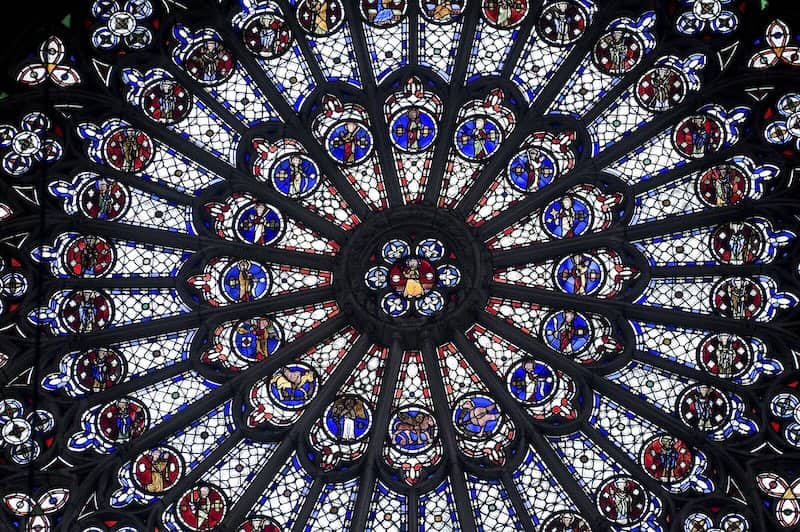 The rose window of Rouen Cathedral
The rose window of Rouen CathedralThe building stone
Two types of stone were used in building. The first was sturdy white stone from the Seine valley. The later use of yellow stone available closer to Paris may have been the result of scarcity of the white stone; the yellow stone was also easier to sculpt.
The spire
The cast iron spire replaced the wooden one after lightning struck it in 1822, and it has again been renovated, this time painted in deep turquoise rather than the original brown. The arrow weighs 9000 tons: 8000 tons of stone and one ton of iron.
The chapels
The cathedral contains numerous small chapels built to venerate saints but also to increase the cathedral’s size.
The main one is dedicated to the Virgin Mary, the Chapelle de la Vierge, and is home to several important tombs. I was particularly intrigued to learn it included that of Louis de Brézé, whose death resulted in the lengthy relationship between his widow, Diane de Poitiers, and King Henri II (the castle of Chenonceau would be the scene of some of their amours).
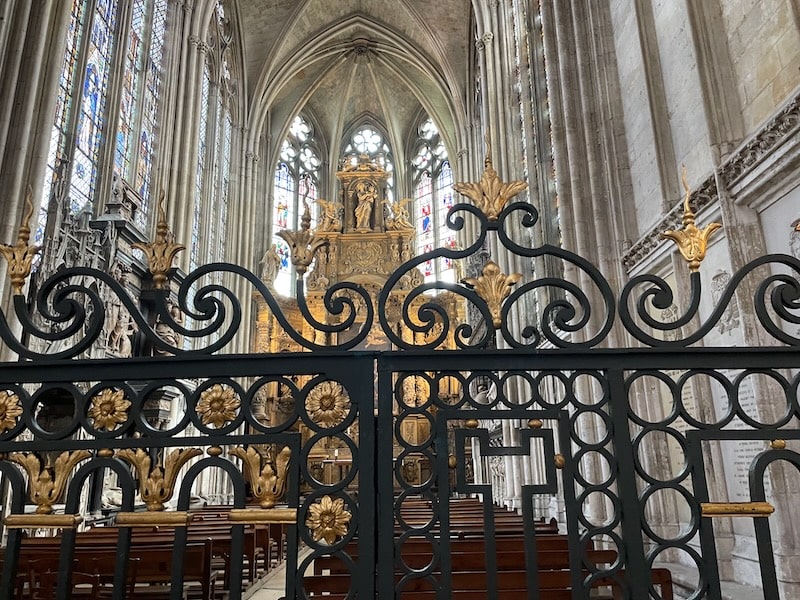 Chapelle de la Vierge at Rouen Cathedral ©OffbeatFrance/Leyla Alyanak
Chapelle de la Vierge at Rouen Cathedral ©OffbeatFrance/Leyla AlyanakFittingly for Rouen, one of the chapels is dedicated to Joan of Arc, her modernist stained glass windows telling the story of her life. At the bottom is the inscription: “From the English in homage”.
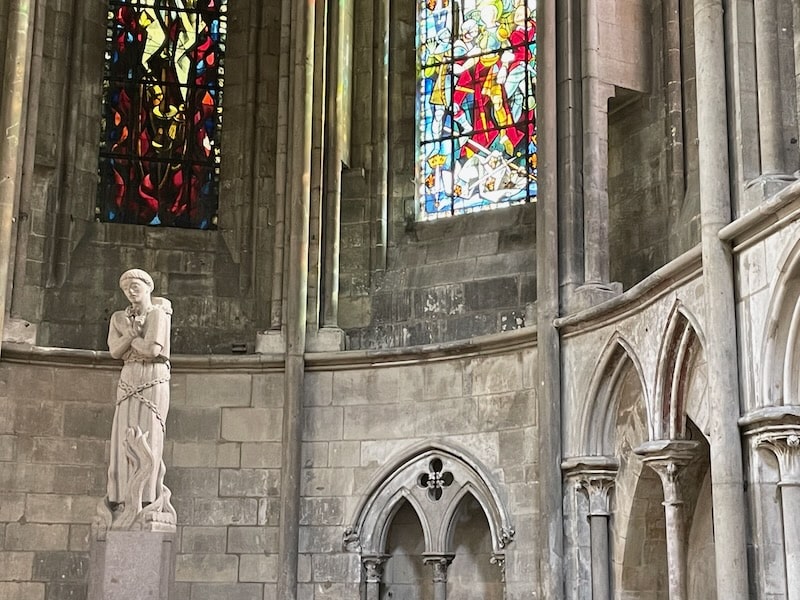 Joan of Arc chapel in Rouen Cathedral - her statue shows her burning at the stake, and above to the right is a stained-glass representation ©OffbeatFrance/Leyla Alyanak
Joan of Arc chapel in Rouen Cathedral - her statue shows her burning at the stake, and above to the right is a stained-glass representation ©OffbeatFrance/Leyla AlyanakThe stairway
A stunning Gothic stairway was built to reach the library during the 15th century, one of the first Norman examples of a straight stairway (most had been spiral until then).
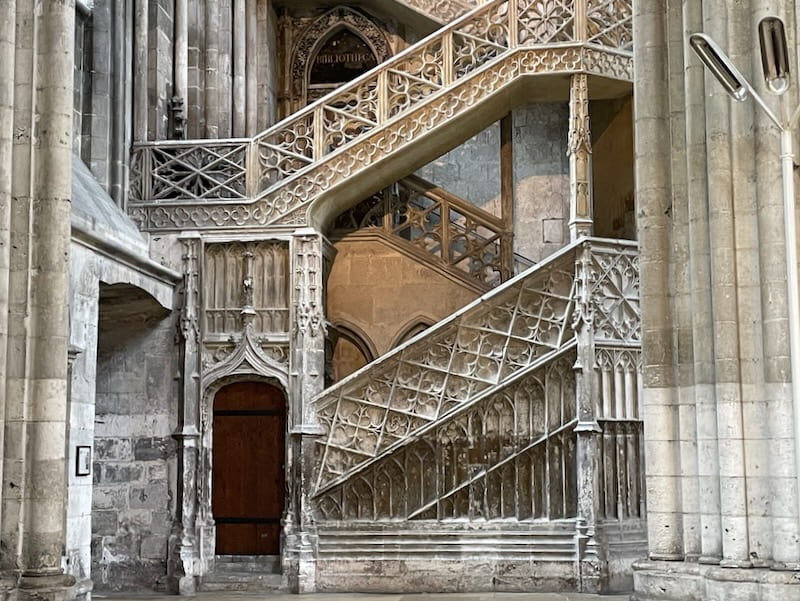 Gothic stairway leading to library at Cathédrale de Rouen ©OffbeatFrance/Leyla Alyanak
Gothic stairway leading to library at Cathédrale de Rouen ©OffbeatFrance/Leyla AlyanakThe statues
Time, weather, war, all these have darkened and helped erode some of the cathedral’s works. The last time major restoration work took place, a number of the façade’s statues were brought indoors and replaced by copies.
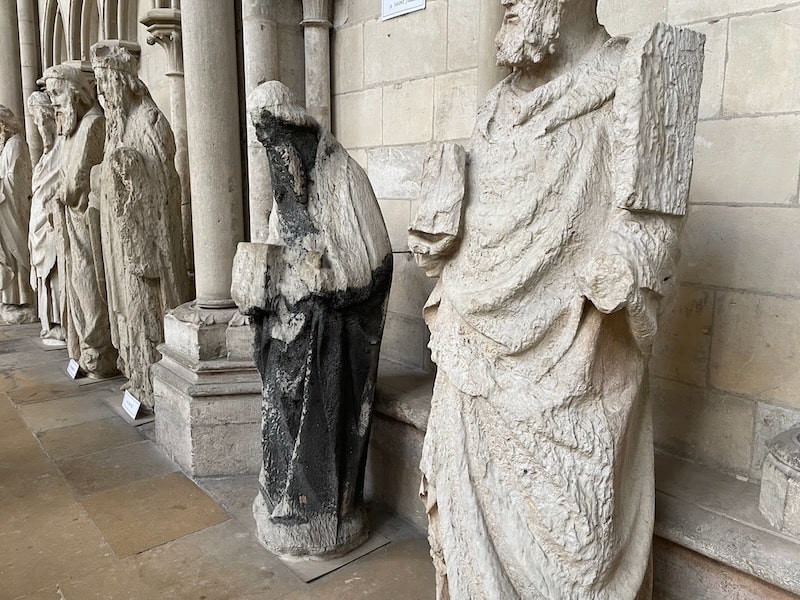 The statues have been under threat from pollution and were moved indoors. Most were cleaned, but a few were left in their original state to show pollution damage. ©OffbeatFrance/Leyla Alyanak
The statues have been under threat from pollution and were moved indoors. Most were cleaned, but a few were left in their original state to show pollution damage. ©OffbeatFrance/Leyla Alyanak5. Through its role as an illustrious necropolis
A bit like the Pantheon or Saint-Denis Basilica in Paris, famous personages are buried here and those with an interest in history come to pay their respects.
The most famous, of course, is the near-mythical Richard the Lionheart, whose heart was buried here and whose “gisant”, or recumbent tomb effigy, is clearly visible.
When he died, his body was split in three, with his entrails buried on the site of his death in battle at Châlus in eastern Aquitaine, his body at the Plantagenet necropolis of Fontevraud Abbey (along with his parents, Henry II of England and Eleonor of Aquitaine), and his heart in Rouen, as per his wishes.
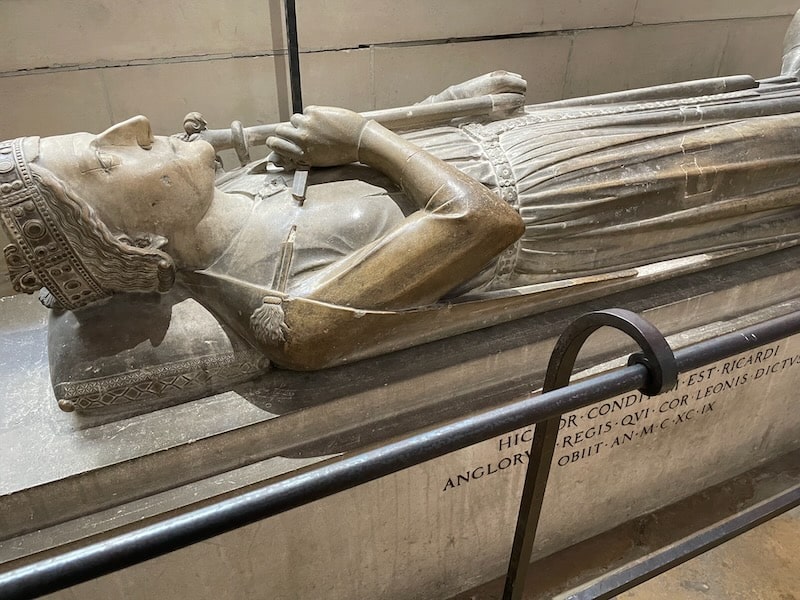 The grave where the heart of Richard the Lionheart was buried in Notre-Dame de Rouen Cathedral ©OffbeatFrance/Leyla Alyanak
The grave where the heart of Richard the Lionheart was buried in Notre-Dame de Rouen Cathedral ©OffbeatFrance/Leyla AlyanakThere are plenty of other recumbent statues buried here include Richard’s brother, Henry; Rollo, first Duke of Normandy; and Rollo’s son William.
6. Through superlatives
We like our “mosts” and our “bests” and Rouen’s cathedral doesn’t lack any of these.
- It is the tallest cathedral in France and boasts the country's tallest spire, at 151m/495ft (for a time, it was the world's tallest building).
- It also has France’s second-largest carillion after Chambéry, and one of the first organs to be seen in a Western church.
- And it has the widest façade in France, 61m/200ft (the façade of Notre-Dame in Paris “only” measures 44m/144ft).
- At 137m/449ft, it is slightly longer than Notre-Dame in Paris, but only by 10m/33ft. Still.
➽ If you're visiting in summer, don't miss the Cathedral's fabulous sound and light show!
7. Through religious significance
Today's imposing cathedral is a very early church. It was appointed seat of the bishop of Rouen in the 3rd century, as early Christianity was spreading and is Normandy’s oldest Christian monument, becoming the See of the Archbishop of Rouen in the 8th century, nearly 1300 years ago.
Nothing has interrupted its religious vocation, with the exception of a few years during the French Revolution.
With Rouen was established as Normandy’s capital, the cathedral slowly became a focal point of Norman spirituality and power. The first Norman duke, Rollo, would be baptized here, sealing the integration of Vikings into Christian and Frankish society.
Before you go…
How about a book recommendation?
You may recall years ago having come across, as a child, a copy of Cathedral: The Story of its Construction by David Macauley, an intriguing black-and-white book filled with architectural drawings of a fictitious cathedral’s interior. That book has now been updated and republished in full color, and while it’s designed for children, it’s also perfect for those of us who need an architectural primer to help us tell a nave from a transept.
The Rouen Cathedral is a living monument of both Christianity and France’s heritage, destroyed and rebuilt, never static and ever-changing, and always enduring in spirit.
Did you enjoy this article? I'd love if you shared it!

